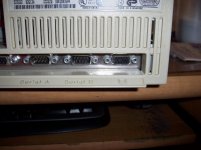Or get a dremel :D (very carefully)
But an adapter would probably be best, as you wouldn't be altering your machine. Those keyed VGA ports aren't very common, so it might have some significance to someone I suppose.
If you could find a really short extension cord, you could just bend that pin down inside the shell, or get some snips and cut it off to make your own adapter.
Now that I think about it, if you look for those small gender changers, you could put a male/male and a female/female, and just take the pin out of one of the male connecters.
That would get you the shortest/neatest adapter probably.
Like these:
http://cgi.ebay.com/VGA-D-sub-Gender-Changer-Adapter-F-to-F-Female-Coupler-/270607498121?pt=LH_DefaultDomain_0&hash=item3f0176bb89
http://cgi.ebay.com/VGA-D-sub-Gender-Changer-Adapter-M-M-Male-Coupler-/280576082653?pt=LH_DefaultDomain_0&hash=item4153a342dd
$1.98 and a pair of pliers and you wouldn't have to modify the machine



